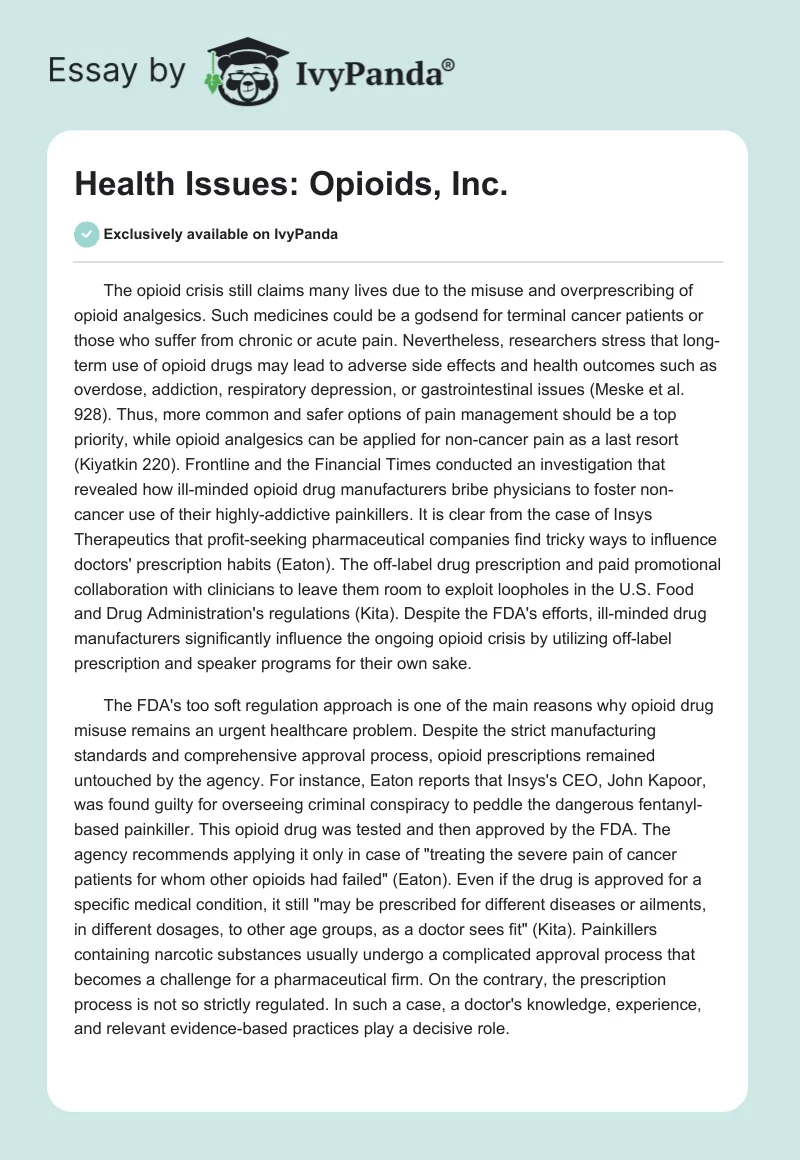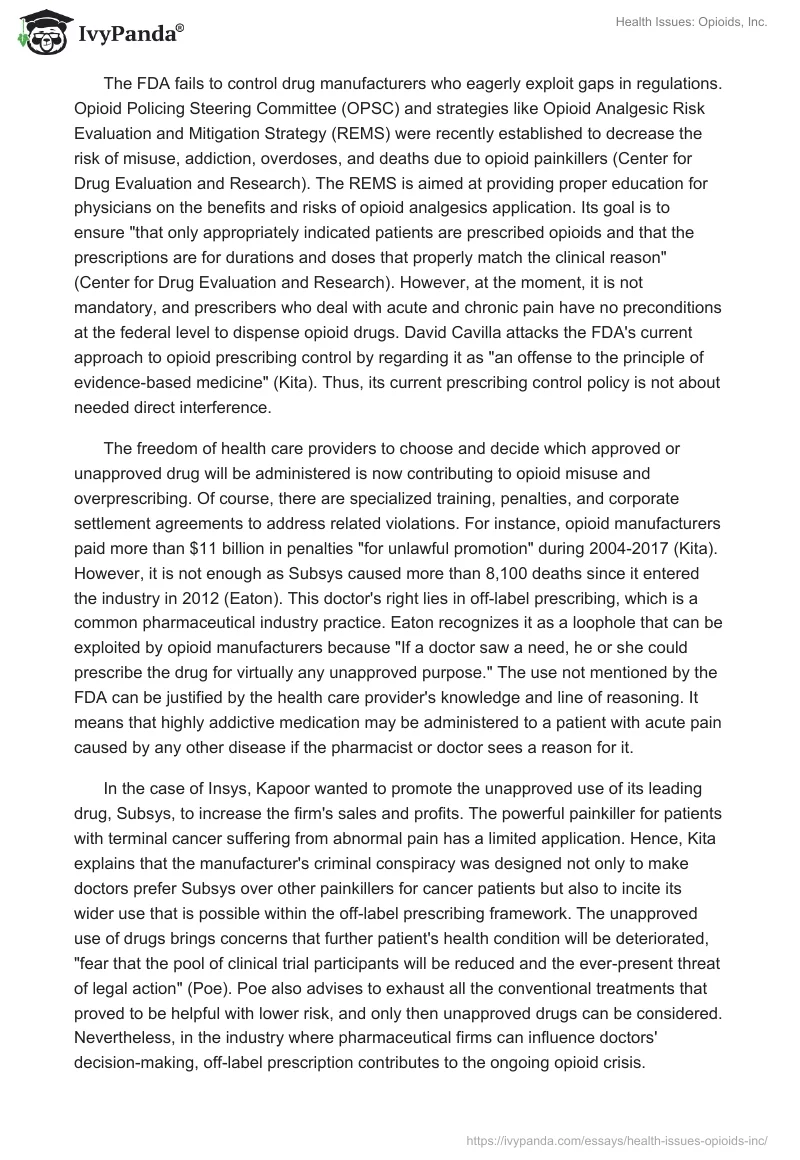The opioid crisis still claims many lives due to the misuse and overprescribing of opioid analgesics. Such medicines could be a godsend for terminal cancer patients or those who suffer from chronic or acute pain. Nevertheless, researchers stress that long-term use of opioid drugs may lead to adverse side effects and health outcomes such as overdose, addiction, respiratory depression, or gastrointestinal issues (Meske et al. 928). Thus, more common and safer options of pain management should be a top priority, while opioid analgesics can be applied for non-cancer pain as a last resort (Kiyatkin 220). Frontline and the Financial Times conducted an investigation that revealed how ill-minded opioid drug manufacturers bribe physicians to foster non-cancer use of their highly-addictive painkillers. It is clear from the case of Insys Therapeutics that profit-seeking pharmaceutical companies find tricky ways to influence doctors’ prescription habits (Eaton). The off-label drug prescription and paid promotional collaboration with clinicians to leave them room to exploit loopholes in the U.S. Food and Drug Administration’s regulations (Kita). Despite the FDA’s efforts, ill-minded drug manufacturers significantly influence the ongoing opioid crisis by utilizing off-label prescription and speaker programs for their own sake.
The FDA’s too soft regulation approach is one of the main reasons why opioid drug misuse remains an urgent healthcare problem. Despite the strict manufacturing standards and comprehensive approval process, opioid prescriptions remained untouched by the agency. For instance, Eaton reports that Insys’s CEO, John Kapoor, was found guilty for overseeing criminal conspiracy to peddle the dangerous fentanyl-based painkiller. This opioid drug was tested and then approved by the FDA. The agency recommends applying it only in case of “treating the severe pain of cancer patients for whom other opioids had failed” (Eaton). Even if the drug is approved for a specific medical condition, it still “may be prescribed for different diseases or ailments, in different dosages, to other age groups, as a doctor sees fit” (Kita). Painkillers containing narcotic substances usually undergo a complicated approval process that becomes a challenge for a pharmaceutical firm. On the contrary, the prescription process is not so strictly regulated. In such a case, a doctor’s knowledge, experience, and relevant evidence-based practices play a decisive role.
The FDA fails to control drug manufacturers who eagerly exploit gaps in regulations. Opioid Policing Steering Committee (OPSC) and strategies like Opioid Analgesic Risk Evaluation and Mitigation Strategy (REMS) were recently established to decrease the risk of misuse, addiction, overdoses, and deaths due to opioid painkillers (Center for Drug Evaluation and Research). The REMS is aimed at providing proper education for physicians on the benefits and risks of opioid analgesics application. Its goal is to ensure “that only appropriately indicated patients are prescribed opioids and that the prescriptions are for durations and doses that properly match the clinical reason” (Center for Drug Evaluation and Research). However, at the moment, it is not mandatory, and prescribers who deal with acute and chronic pain have no preconditions at the federal level to dispense opioid drugs. David Cavilla attacks the FDA’s current approach to opioid prescribing control by regarding it as “an offense to the principle of evidence-based medicine” (Kita). Thus, its current prescribing control policy is not about needed direct interference.
The freedom of health care providers to choose and decide which approved or unapproved drug will be administered is now contributing to opioid misuse and overprescribing. Of course, there are specialized training, penalties, and corporate settlement agreements to address related violations. For instance, opioid manufacturers paid more than $11 billion in penalties “for unlawful promotion” during 2004-2017 (Kita). However, it is not enough as Subsys caused more than 8,100 deaths since it entered the industry in 2012 (Eaton). This doctor’s right lies in off-label prescribing, which is a common pharmaceutical industry practice. Eaton recognizes it as a loophole that can be exploited by opioid manufacturers because “If a doctor saw a need, he or she could prescribe the drug for virtually any unapproved purpose.” The use not mentioned by the FDA can be justified by the health care provider’s knowledge and line of reasoning. It means that highly addictive medication may be administered to a patient with acute pain caused by any other disease if the pharmacist or doctor sees a reason for it.
In the case of Insys, Kapoor wanted to promote the unapproved use of its leading drug, Subsys, to increase the firm’s sales and profits. The powerful painkiller for patients with terminal cancer suffering from abnormal pain has a limited application. Hence, Kita explains that the manufacturer’s criminal conspiracy was designed not only to make doctors prefer Subsys over other painkillers for cancer patients but also to incite its wider use that is possible within the off-label prescribing framework. The unapproved use of drugs brings concerns that further patient’s health condition will be deteriorated, “fear that the pool of clinical trial participants will be reduced and the ever-present threat of legal action” (Poe). Poe also advises to exhaust all the conventional treatments that proved to be helpful with lower risk, and only then unapproved drugs can be considered. Nevertheless, in the industry where pharmaceutical firms can influence doctors’ decision-making, off-label prescription contributes to the ongoing opioid crisis.
Health care professionals are allowed to receive monetary rewards from pharmaceutical companies for promotional work, medical research, and speaker programs. It is a legal practice to earn fees for promoting specific medicines among their peers by highlighting their benefits. Although there are legitimate ways for manufacturers to reward a practitioner, it is unlawful “for doctors to prescribe the drug in exchange for kickback payments from a manufacturer” (Kessler et al.). Recent Frontline/Financial Times investigation found that clinicians who receive such payments more often prescribe drugs they were chosen to promote (Kuchler et al.). In terms of Insys, the CEO and his chief salesman opted to pay doctors “simply to write masses of Subsys prescriptions for all kinds of ailments” (Eaton). Moreover, Insys salespeople were financially encouraged to find as many practitioners eager to accept a bribe as possible. In their turn, such doctors overprescribe Subsys and increase doses for long-term treatment of chronic pain. Drug sellers benefit from boosted off-label prescriptions exploiting the existing legal ways of doctor-manufacturer collaboration. Instead of administering safer options in the patient’s best interest, they prescribe opioid painkillers in their financial interest.
On the contrary, unapproved use of approved drugs by the FDA reserves room for healthcare providers to tailor the treatment of a specific patient. Thus, the off-label approach makes them able to detect unique disease conditions and prescribe the allegedly most suited therapy. For instance, in a case when there is no approved drug for a particular medical condition or all of them were already tried, the off-label prescription may be a life-saving strategy (Chelsea Weidman Burke). For instance, the other opioid painkiller Actiq, usually administered for cancer pain, can be useful in curbing migraine. Such fentanyl drugs can provide quick relief for those who suffer from severe breakthrough pain. Meske and others found that “there is an ample evidence base supporting the efficacy of opioid analgesics for at least three months’ duration” (931). The prescribing practice of opioids use for non-cancer patients, especially short-term ones may make the patient’s life easier by eliminating chronic pain; thus, unapproved usage might be a case.
Nevertheless, opioids have severe risks and side effects that can be tolerated only in the case of last resort measures. Kiyatkin reveals that “opioid drugs have strong addictive potential, predisposing individuals for their repeated, non-medical use” (219). Despite the short-run efficacy of opioid painkillers, long-term consumption often results in the patient’s addiction and broad health complications. The dose of opioid analgesics should be continuously increased to keep its effectiveness in the long run. Higher doses cause addiction and side effects such as sedation, respiratory depression, and inhibition of gastrointestinal activity. The private pharmacological industry convinces doctors to prescribe dangerous painkillers, and its unapproved use heavily contributes to the current opioid crisis. The main problem is that professionals resort to opioids too often, even in situations when other pain treatments may work better. Meske and colleagues highlight that long-term opioid therapy risks usually outweigh its effectiveness (930). In such cases, when there is no clear benefit, threats should not be tolerated.
To conclude, the freedom of pharmacists and physicians to administer opioid drugs for non-cancer patients is a controversial practice in times of ongoing opioid crisis. There is not enough control of the prescribing process from the FDA, especially in contrast to drug approval. Despite the short-term efficacy of such painkillers, they become dangerous when used for long-term pain management. Health care providers can recommend medicine off-label when they think it will help their patients. Drug manufacturers abuse legal ways such as speaker programs and promotional work to encourage overprescribing of their opioid analgesics in non-cancer cases. Hence, the FDA should revise its regulations to address the industry’s loopholes.
Works Cited
Center for Drug Evaluation and Research. “Opioid Medications.”FDA, 2020, Web.
Chelsea Weidman Burke, M.S. “The Common, Yet Unspoken, Practice of Off-Label Drug Prescribing.”BioSpace, 2019, Web.
Eaton, Joe. “How a Drugmaker Bribed Doctors and Helped Fuel the Opioid Epidemic.”AARP. 2020, Web.
Kessler, Aaron, et al. “CNN Exclusive: The More Opioids Doctors Prescribe, the More Money They Make.”CNN, 2018, Web.
Kita, Joe. “What You Need to Know About Off-Label Drugs.”AARP. 2019, Web.
Kiyatkin, Eugene. “Respiratory Depression and Brain Hypoxia-Induced by Opioid Drugs: Morphine, Oxycodone, Heroin, and Fentanyl.” Neuropharmacology, vol. 151, 2019, pp. 219-226.
Kuchler, Hanna, et al. “Opioids, Bribery and Wall Street: The Inside Story of a Disgraced Drugmaker.”Frontline, 2020, Web.
Meske, Diana, et al. “Efficacy of Opioids Versus Placebo in Chronic Pain: A Systematic Review and Meta-analysis of Enriched Enrollment Randomized Withdrawal Trials.” Journal of Pain Research, vol. 11,2018, pp. 923-934.
Poe, Michelle. “The Pros and Cons of Off-label Prescriptions.”Dr. Drew, 2017, Web.


